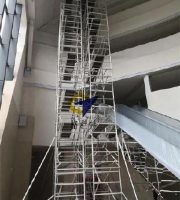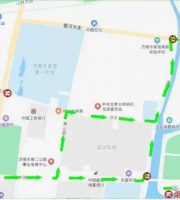For different diversion stages and different buildings, the specified frequency is also different.
The dam body of local materials is generally not allowed to flow.
The concrete dam is usually allowed to flow, which can be considered according to the annual diversion standard or the diversion in dry season.
When the flow with monthly design frequency is used to arrange the construction progress, the hydrological characteristics of the river shall be fully demonstrated and treated with caution.
Propose the construction sequence of diversion structures, the construction method of removing cofferdams and plugging diversion structures; 4.
Bottom outlet diversion is used for concrete dam construction, and all or part of the water flow is directed downstream through the temporary or permanent drain holes set in the dam body.
Careful design shall be made in advance.
The construction diversion method is divided into full section cofferdam method and section cofferdam method.
It is generally used in the construction of earth dam, rockfill dam and other projects.
The general requirements are:; The flood standard in the initial diversion stage can be lower, and the flood standard in the middle and later diversion stages can be gradually improved.
Diversion outside the riverbed: cofferdam is used to block the whole riverbed at one time, so that the river can be directed downstream through the diversion and discharge structure outside the riverbed; Diversion in riverbed: cofferdam is used to enclose part of the riverbed successively, and the river is guided through another part of the riverbed narrowed, that is, diversion by stages.
The diversion mode is divided into two types according to the riverbed position: diversion outside the riverbed and diversion inside the riverbed.
The water retaining height of cofferdams and diversion and discharge structures only consider the flow in dry season.
Culvert pipes are easy to be arranged on the river beach when they are constructed in dry land, and the Beach elevation is above the low water level.
For concrete and masonry buildings, the flood standard is lower, while for earth rock dams, the flood standard is higher.
1.
Construction diversion is a very important engineering measure in the construction of water conservancy projects, especially in the construction of gate and dam projects.
According to the type of discharge structure, it is divided into open channel diversion, tunnel diversion, culvert, dam bottom outlet, comb and notch overflow, culvert pipe diversion and other diversion methods.
③ In the later stage of diversion, that is, from the blocking of diversion and discharge structures to the full repair of the dam to the design elevation, the permanent discharge structures have been put into operation.
If the riverbed is wide and there are navigation requirements during the construction period, phased diversion can be adopted; If the river channel is narrow, open channels or tunnels should be used for diversion according to topographical and geological conditions.
3.
The construction diversion measures are restricted by many factors.
② Medium term diversion, i.e.
When the dam body construction is difficult to reach the flood detention elevation in the flood season, the cofferdam elevation and the scale of diversion structures shall be considered according to the annual diversion standard.
With the rise of the dam body, the storage capacity increases and the flood control capacity increases gradually.
Introduction construction diversion refers to the use of Cofferdam to maintain the foundation pit and direct the water flow to the predetermined discharge structure to the downstream in order to keep the hydraulic structure on the dry ground during construction, which is called construction diversion.
Culvert diversion is a construction method using culvert for diversion, which is suitable for rivers with small diversion flow or only used for diversion in dry season.
Full section cofferdam method defines full section cofferdam method, also known as one-time blocking method or diversion outside riverbed..
Because too many culvert pipes are unfavorable to the dam body and interfere with the dam construction, it is not suitable to bury too many pipes under the dam, and the size of single pipe should not be too large.
② Topographical conditions.
On the other hand, the diversion design standard also varies with the level of permanent buildings.
The selection of diversion mode shall generally consider: ① hydrological conditions.
Determine comprehensive utilization measures such as navigation, water passage and water supply during the construction period.
In the construction diversion design, the diversion period shall be selected, that is, within the working duration of the water retaining cofferdam, whether to retain water in dry season or throughout the year.
For rivers with large water level variation, overflow cofferdams should be used sometimes.
Formulate flood control and foundation pit drainage measures; 5.
④ Meet the comprehensive utilization requirements of navigation, wood crossing, water supply and irrigation during construction.
all directly affect the scheme selection.
The diversion period shall be reasonably divided and selected according to the hydrological characteristics of the river, the construction characteristics and progress of the main works.
The diversion design standard is the regulation of the design flow frequency adopted in the diversion design.
Diversion function in the process of building water conservancy projects in water areas (most refer to live water rivers), in order to create dry land construction conditions, cofferdam is used to enclose the foundation pit in the early stage, and the river flow bypasses the construction site and leads to the downstream in a predetermined way.
At this time, the diversion and discharge structures have not been blocked, and the dam body will retain water in flood season.
For example, the diversion tunnel can be combined with the flood discharge tunnel, and the cofferdam can be combined with the dam body of the earth rock dam.
Culvert diversion is generally used for small and medium-sized sluice, earth rock dam and other projects.
If necessary, model experiments shall be conducted, repeated demonstration shall be conducted, and then the decision shall be made.
The selection of diversion scheme is related to the construction period, quality, cost and safety of the whole project.
Small projects shall be built in a dry season to simplify diversion facilities; Large and medium-sized projects are generally difficult to be completed in a dry season, so annual diversion can be considered, and the diversion design flow shall be subject to the flood flow with a certain frequency throughout the year.
The design contents mainly include: 1.
A complete scheme needs to be compared through technology and economy.
cofferdam water retaining stage, from the closure of the riverbed to the construction of the dam body above the cofferdam elevation.
dam water retaining stage.
③ If possible, the discharge structures of permanent hydraulic structures shall be used as much as possible for construction diversion.
River flow, hydrograph characteristics, flood and low flow conditions, water level variation, drift ice, etc.
Select diversion period, design standard, diversion flow, diversion mode and diversion structure type; 3.
Comb diversion is to reserve comb notch for overflow during the construction of concrete dam, and block the notch in turn with the rise of dam body.
4 design standard according to the construction progress of the project and the discharge conditions of each period, the construction diversion can be divided into three stages: ① initial diversion, i.e.
When the project is required to play its role in advance (such as power generation in advance), the flood control standard in the corresponding diversion stage should be higher.
The diversion design shall adopt the maximum flow and flood volume of the design frequency during the diversion period.
1.
Master and analyze the hydrological characteristics of the river and the basic data such as meteorology, topography and geology of the project site; 2.
2.



